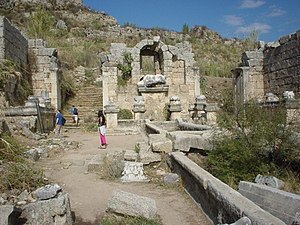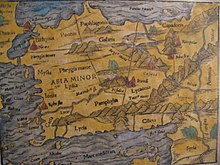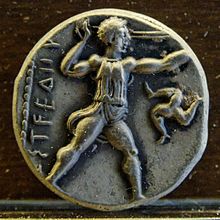Pamfilia: Perbedaan antara revisi
JohnThorne (bicara | kontrib) ←Membuat halaman berisi '{{Infobox | bodyclass = geography | abovestyle = background:#DEB887; | subheader = Daerah Kuno di Anatolia | above = Pamfilia<br>Pamphylia (Παμφυλία) | image =...' |
JohnThorne (bicara | kontrib) Tidak ada ringkasan suntingan |
||
| Baris 48: | Baris 48: | ||
*Mnaseas (putra Artemon) dari [[Side]], sculptor (end 3rd century BC)<ref>IK Side I 1</ref> |
*Mnaseas (putra Artemon) dari [[Side]], sculptor (end 3rd century BC)<ref>IK Side I 1</ref> |
||
*Orestas (putra Erymneus) dari [[Aspendos]], [[proxenos]] in [[Dreros]] (Crete), (end 3rd - beginning 2nd century BC)<ref>BCH 1936:280,1</ref> |
*Orestas (putra Erymneus) dari [[Aspendos]], [[proxenos]] in [[Dreros]] (Crete), (end 3rd - beginning 2nd century BC)<ref>BCH 1936:280,1</ref> |
||
*Thymilus dari [[Aspendos]], |
*Thymilus dari [[Aspendos]], juara lari (jarak 180–190 m) stadion dalam Olimpiade tahun 176 SM <ref>{{cite web|url=http://www.attalus.org/names/t/thymilus.html |title=links to Greek and Latin Authors in the web |publisher=Attalus |date= |accessdate=2013-09-03}}</ref> |
||
*Apollonios (putra Koiranos) dari Aspendos, Ptolemaic commander, [[proxenos]] in [[Argyroupoli (Rethymno)|Lappa]] and [[Aptera]] (Crete) (1st half - 2nd century BC)<ref>SEG 23:573 R.S. Bagnall (1976) The Administration of the Ptolemaic Possessions outside Egypt, p. 124. Brill Archive.</ref> |
* Apollonios (putra Koiranos) dari Aspendos, Ptolemaic commander, [[proxenos]] in [[Argyroupoli (Rethymno)|Lappa]] and [[Aptera]] (Crete) (1st half - 2nd century BC)<ref>SEG 23:573 R.S. Bagnall (1976) The Administration of the Ptolemaic Possessions outside Egypt, p. 124. Brill Archive.</ref> |
||
*Asclepiades (putra Myron) dari Perga, |
* Asclepiades (putra Myron) dari Perga, tabib yang dihormati oleh penduduk (''demos'') Seleukia di Pamfilia (abad ke-3 sampai ke-2 SM)<ref>Epigr.Anat. 11:104,5 [http://aroonchande.com/files/AM/Inscriptions%20for%20Physicians.pdf Inscriptions for Physicians ]</ref> |
||
* [[Plancia Magna]] dari Perga, influential citizen, benefactress, high-priestess of Artemis (1st and 2nd century AD)<ref>Elaine Fantham, Helene Peet Foley, Natalie Boymel Kampen, Sarah B. Pomeroy & H. Alan Shapiro (1995) Women in the Classical World: Image and Text, Oxford University Press</ref> |
* [[Plancia Magna]] dari Perga, influential citizen, benefactress, high-priestess of Artemis (1st and 2nd century AD)<ref>Elaine Fantham, Helene Peet Foley, Natalie Boymel Kampen, Sarah B. Pomeroy & H. Alan Shapiro (1995) Women in the Classical World: Image and Text, Oxford University Press</ref> |
||
*Menodora (putri Megacles) dari [[Sillyon]], |
*Menodora (putri Megacles) dari [[Sillyon]], magistrat dan benefaktor (c. abad ke-2 M)<ref>Riet van Bremen: Women and Wealth Chapter 14, p. 223 in "Images of Women in Antiquity" [http://books.google.com/books?id=96gd90oDpwC&pg=PA223&dq=of+Sillyon&sig=RXGEJQLOfYhiW3RaKYLHi8BO5X4 Page 223] Editors Averil Cameron, Amélie Kuhrt ISBN 0-415-09095-4</ref> |
||
* Zenon (putra Theodorus) dari [[Aspendos]], |
* Zenon (putra Theodorus) dari [[Aspendos]], arsitek teater Aspendos (abad ke-2 M)<ref>{{cite web|url=http://www.aspendosproject.com/about.html#Structures |title=Aspendos Archaeological Project |publisher=Aspendosproject.com |date= |accessdate=2013-09-03}}</ref> |
||
*Apollonius dari Aspendos (putra Apollonius), |
*Apollonius dari Aspendos (putra Apollonius), penyair (abad ke-2 M/awal abad ke-3 M)<ref>IG VII 1773 - The Context of Ancient Drama |
||
[http://books.google.com/books?id=3DGXKt0IpIMC&pg=PA192&dq=Apollonios++of+Aspendos&sig=AQry3iFBWyFfDfq10HL3fvAUOuU#PPA192,M1 Page 192] By Eric Csapo, William J. Slater ISBN 0-472-08275-2</ref> |
[http://books.google.com/books?id=3DGXKt0IpIMC&pg=PA192&dq=Apollonios++of+Aspendos&sig=AQry3iFBWyFfDfq10HL3fvAUOuU#PPA192,M1 Page 192] By Eric Csapo, William J. Slater ISBN 0-472-08275-2</ref> |
||
* [[Aurelia Paulina]] from Perga, |
* [[Aurelia Paulina]] from Perga, bangsawati terkenal asal Siria, penyantun, imam perempuan dewi Artemis (abad ke-2 dan ke-3 M) |
||
* |
* Probus dari Side, martir (meninggal c. 304 M) |
||
* [[Philip |
* [[Philip dari Side]], sejarawan(c. 380 - setelah 431) |
||
* [[Matrona |
* [[Matrona dari Perge]], saint, abbess of Constantinople, (late 5th - early 6th century AD)<ref>{{cite web|url=http://www.fordham.edu/halsall/basis/matrona.asp |title=Internet Medieval Sourcebook |publisher=Fordham.edu |date= |accessdate=2013-09-03}}</ref> |
||
* [[Antony I |
* [[Antony I dari Constantinople|Antony I Kassymatas]] dari Sillyon, patriark Konstantinopel (c. 780 - 837) |
||
== Situs arkeologi == |
== Situs arkeologi == |
||
Revisi per 13 November 2013 18.11
| Pamfilia Pamphylia (Παμφυλία) | |
|---|---|
| Daerah Kuno di Anatolia | |
 Reruntuhan jalan utama di Perga, ibukota Pamfilia | |
| Lokasi | Anatolia selatan |
| Bekas negara: | - |
| Suku bangsa | Pamfilia, Pisidia, Yunani |
| Ibukota | Perga |
| Provinsi Romawi | Pamphylia |
 | |
Pamfilia (Yunani: Παμφυλία; Inggris: Pamphylia) adalah sebuah daerah (pada geografi kuno) di bagian selatan Asia Minor, antara Likia dan Kilikia, membentang dari Laut Tengah ke Pegunungan Taurus (di wilayah Provinsi Antalya, negara Turki modern). Berbatasan di sebelah utara dengan Pisidia dan karenanya merupakan suatu negeri yang luasnya sempit, dengan garis pantai hanya sepanjang 120 km (75 mil) dengan lebar sekitar 50 km (30 mil). Di bawah administrasi Romawi, istilah Pamfilia dikembangkan untuk mencakup Pisidia dan seluruh wilayah sampai perbatasan Frigia dan Likaonia; inilah definisi yang dianut oleh Ptolemeus.
Etimologi
Nama Pamfilia berasal dari bahasa Yunani Παμφυλία,[1] yang asalnya dari πάμφυλος (pamphylos), secara harfiah "dari suku atau ras campuran",[2] suatu gabungan dari kata πᾶν (pan), bentuk netral dari πᾶς (pas) "semua"[3] + φυλή (phylē), "ras, suku bangsa".[4] Herodotus merunut etimologi dari sebuah suku Dorian, Pamphyloi (Πάμφυλοι), yang dikatakan telah mengkolonisasi daerah itu.[5] Suku ini kemudian dinamakan menurut Pamphylos (Yunani: Πάμφυλος), putra Aigimios.[6][7]
Asal usul orang Pamfilia
Orang Pamfilia merupakan campuran penduduk asli dengan imigran dari Kilikia dan Yunani[8] yang bermigrasi ke sana dari Arkadia dan Peloponnesus pada abad ke-12 SM.[9] Pentingnya kontribusi budaya Yunani pada asal usul orang Pamfilia dapat dilihat dari tradisi dan arkeologi[10] sehingga Pamfilia dapat dianggap bagian negeri orang Yunani dari awal Zaman Besi sampai awal Abad Pertengahan.[11] Tidak diragukan bahwa orang Pamfilia dan Pisidia sebenarnya bangsa yang sama, meskipun Pamfilia menerima koloni dari Yunani dan negeri-negeri lain, dan karenanya, ditambah kesuburan tanahnya, menjadi lebih beradab dari tetangga-tetangganya yang lebih di daratan dalam. Namun perbedaan di antara kedua daerah ini sudah ditetapkan sejak zaman kuno. Herodotus, yang tidak menyebut Pisidia, menghitung orang Pamfilia di antara bangsa-bangsa di Asia Minor, sedangkan Ephorus menyebut keduanya, dengan tepat memasukkan Pamfilia sebagai salah satu bangsa di pantai, sedangkan Pisidia ke dalam bangsa-bangsa di pedalaman.



Daftar tokoh Pamfilia terkenal
- Diodorus dari Aspendos, Pythagorean philosopher (4th century BC)[12][13]
- Apollonius dari Perga, astronomer, mathematician (c. 262 - c. 190 BC)
- Artemidorus dari Perga, proxenos in Oropos (c. 240 -180 BC)[14]
- Aetos (putra Apollonius) dari Aspendos, Ptolemaic commander, founder of Arsinoe (Cilicia) (c. 238 BC)[15]
- Mnaseas (putra Artemon) dari Side, sculptor (end 3rd century BC)[16]
- Orestas (putra Erymneus) dari Aspendos, proxenos in Dreros (Crete), (end 3rd - beginning 2nd century BC)[17]
- Thymilus dari Aspendos, juara lari (jarak 180–190 m) stadion dalam Olimpiade tahun 176 SM [18]
- Apollonios (putra Koiranos) dari Aspendos, Ptolemaic commander, proxenos in Lappa and Aptera (Crete) (1st half - 2nd century BC)[19]
- Asclepiades (putra Myron) dari Perga, tabib yang dihormati oleh penduduk (demos) Seleukia di Pamfilia (abad ke-3 sampai ke-2 SM)[20]
- Plancia Magna dari Perga, influential citizen, benefactress, high-priestess of Artemis (1st and 2nd century AD)[21]
- Menodora (putri Megacles) dari Sillyon, magistrat dan benefaktor (c. abad ke-2 M)[22]
- Zenon (putra Theodorus) dari Aspendos, arsitek teater Aspendos (abad ke-2 M)[23]
- Apollonius dari Aspendos (putra Apollonius), penyair (abad ke-2 M/awal abad ke-3 M)[24]
- Aurelia Paulina from Perga, bangsawati terkenal asal Siria, penyantun, imam perempuan dewi Artemis (abad ke-2 dan ke-3 M)
- Probus dari Side, martir (meninggal c. 304 M)
- Philip dari Side, sejarawan(c. 380 - setelah 431)
- Matrona dari Perge, saint, abbess of Constantinople, (late 5th - early 6th century AD)[25]
- Antony I Kassymatas dari Sillyon, patriark Konstantinopel (c. 780 - 837)
Situs arkeologi
- Antalya
- Aspendos
- Eurymedon Bridge at Aspendos, a Roman bridge which was reconstructed by the Seljuks and follows a zigzag course over the river
- Eurymedon Bridge at Selge, a Roman bridge
- Perga
- Side
- Sillyon
Lihat pula
- Barnabas
- Paulus dari Tarsus
- Pisidia
- Bagian Alkitab yang berkaitan: Kisah Para Rasul 2, 13, 14, 15, 27
Referensi
- ^ Παμφυλία, Henry George Liddell, Robert Scott, A Greek-English Lexicon, on Perseus
- ^ πάμφυλος, Henry George Liddell, Robert Scott, A Greek-English Lexicon, on Perseus
- ^ πᾶς, Henry George Liddell, Robert Scott, A Greek-English Lexicon, on Perseus
- ^ φυλή, Henry George Liddell, Robert Scott, A Greek-English Lexicon, on Perseus
- ^ Herodotus, The Histories, 5.68
- ^ Πάμφυλος, William J. Slater, Lexicon to Pindar, on Perseus
- ^ George Grote : A History of Greece. p. 286; Irad Malkin : Myth and Territory in the Spartan Mediterranean. Cambridge U Pr, 2003. p. 41.
- ^ Pamphylia, Encyclopædia Britannica
- ^ Ahmad Hasan Dani, Jean-Pierre Mohen, J. L. Lorenzo, and V. M. Masson , History of Humanity-Scientific and Cultural Development: From the Third Millennium to the Seventh Century B.C (Vol II), UNESCO, 1996, p.425
- ^ Arnold Hugh Martin Jones, The cities of the eastern Roman provinces, Clarendon Press, 1971, p.123
- ^ John D. Grainger, The cities of Pamphylia, Oxbow Books, 2009, p.27
- ^ "Dictionary of Greek and Roman Biography and Mythology, page 1015 (v. 1)". Ancientlibrary.com. Diakses tanggal 2013-09-03.
- ^ Die Fragmente Der Griechischen Historiker, Continued - Google Boeken. Books.google.com. Diakses tanggal 2013-09-03.
- ^ Epigr. tou Oropou 148
- ^ SEG 39:1426 - The Hellenistic Monarchies: Selected Papers Page 264 By Christian Habicht ISBN 0-472-11109-4
- ^ IK Side I 1
- ^ BCH 1936:280,1
- ^ "links to Greek and Latin Authors in the web". Attalus. Diakses tanggal 2013-09-03.
- ^ SEG 23:573 R.S. Bagnall (1976) The Administration of the Ptolemaic Possessions outside Egypt, p. 124. Brill Archive.
- ^ Epigr.Anat. 11:104,5 Inscriptions for Physicians
- ^ Elaine Fantham, Helene Peet Foley, Natalie Boymel Kampen, Sarah B. Pomeroy & H. Alan Shapiro (1995) Women in the Classical World: Image and Text, Oxford University Press
- ^ Riet van Bremen: Women and Wealth Chapter 14, p. 223 in "Images of Women in Antiquity" Page 223 Editors Averil Cameron, Amélie Kuhrt ISBN 0-415-09095-4
- ^ "Aspendos Archaeological Project". Aspendosproject.com. Diakses tanggal 2013-09-03.
- ^ IG VII 1773 - The Context of Ancient Drama Page 192 By Eric Csapo, William J. Slater ISBN 0-472-08275-2
- ^ "Internet Medieval Sourcebook". Fordham.edu. Diakses tanggal 2013-09-03.
Pranala luar
- Livius.org: Pamphylia
- Asia Minor Coins: Pamphylia ancient Greek and Roman coins from Pamphylia
Templat:Historical regions of Anatolia
![]() Artikel ini menyertakan teks dari suatu terbitan yang sekarang berada pada ranah publik: Chisholm, Hugh, ed. (1911). "perlu nama artikel ". Encyclopædia Britannica (edisi ke-11). Cambridge University Press.
Artikel ini menyertakan teks dari suatu terbitan yang sekarang berada pada ranah publik: Chisholm, Hugh, ed. (1911). "perlu nama artikel ". Encyclopædia Britannica (edisi ke-11). Cambridge University Press.

